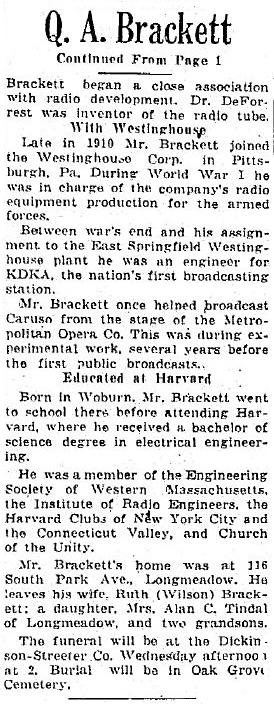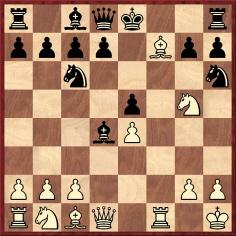Chess Notes
Edward Winter
When contacting us by e-mail, correspondents are asked to include their name and full postal address and, when providing information, to quote exact book and magazine sources. The word ‘chess’ needs to appear in the subject-line or in the message itself.
| First column | << previous | Archives [85] | next >> | Current column |
7188. Can Black win?
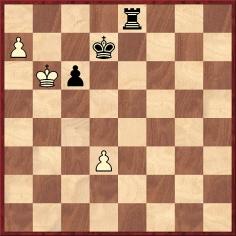
Black to move
7189. Steinitz’s children
Is information available on Steinitz’s children William
and Julia (or Juliett), both of whom were born in the
1890s? A lead is provided by the 1910 US census (see the FamilySearch.org
website), which lists them as the stepchildren of Peter
Baust, the address being Queens Ward 2, Queens, New York:
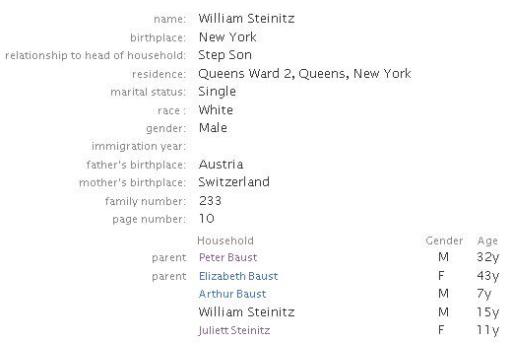
7190. Seesaw/windmill manoeuvre
Oliver Dunne (Dublin) submits a game with the unusual possibility of the seesaw/windmill manoeuvre occurring with either rook:
Oliver Dunne – Pat FitzsimonsKing’s Fianchetto Opening
Armstrong Cup team match, Dublin, 24 September 2007
1 g3 e5 2 Nf3 Nc6 3 d4 exd4 4 Nxd4 Qf6 5 c3 Bc5 6 Be3 Nxd4 7 cxd4 Bb4+ 8 Nd2 Ne7 9 Bg2 O-O 10 O-O Bxd2 11 Bxd2 Qxd4 12 Qc2 c6 13 Bc3 Qg4 14 Rad1 d5 15 Rd4 Qg6 16 Qxg6 Nxg6 17 e4 dxe4 18 Bxe4 Be6 19 Rb4 Bh3 20 Rc1 Rab8 21 f4 Bd7 22 Bxg6 hxg6 23 Be5 Ra8 24 Rxb7 Be6 25 Rxc6 Bd5
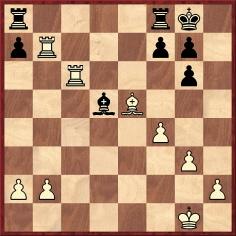
26 Rxg6 Bxb7 27 Rxg7+ Kh8 28 Rxf7+ Kg8 29 Rg7+ Kh8 30 Rxb7+ Kg8 31 Rg7+ Kh8 32 Rxa7+ Kg8 33 Rg7+ Kh8 34 g4 Rfe8 35 Rg5+ Kh7 36 Rg7+ Kh8 37 Re7+ Kg8 38 Rxe8+ Rxe8 39 h4 Kf7 40 Kf2 Rc8 41 Bc3 Rd8 42 f5 Rd1 43 Kg2 Rd3 44 g5 Rd5 45 g6+ Kg8 46 f6 Rd6 47 f7+ Kf8 48 Bb4 Kg7 49 Bxd6 Kxg6 50 f8(R) Resigns.
7191. AVRO, 1938 (C.N. 7162)
From Chess Review, January 1939, page 7:
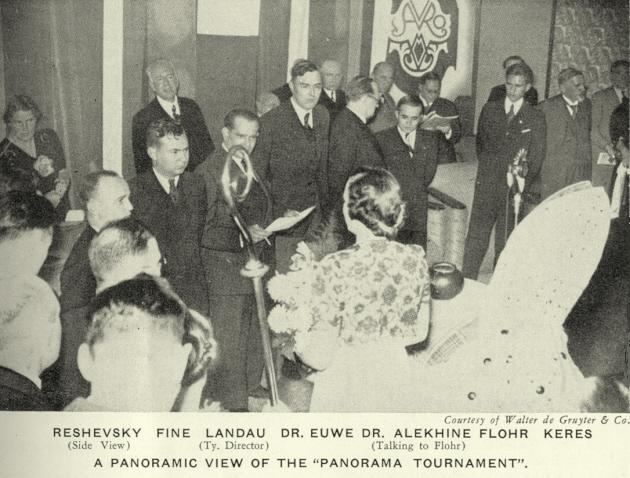
7192. Picabia v Roché
From Oliver Beck (Seattle, WA, USA):
‘In 1917 Francis Picabia challenged Henri-Pierre Roché to a game of chess to determine the fate of two rival New York avant-garde magazines. Picabia, who published 391, beat Roché, who was then forced to cease publication of The Blind Man, which he produced with Marcel Duchamp and Beatrice Wood. The game-score appeared in Rongwrong (July 1917), a one-time Dada journal also published by Roché, Duchamp and Wood:
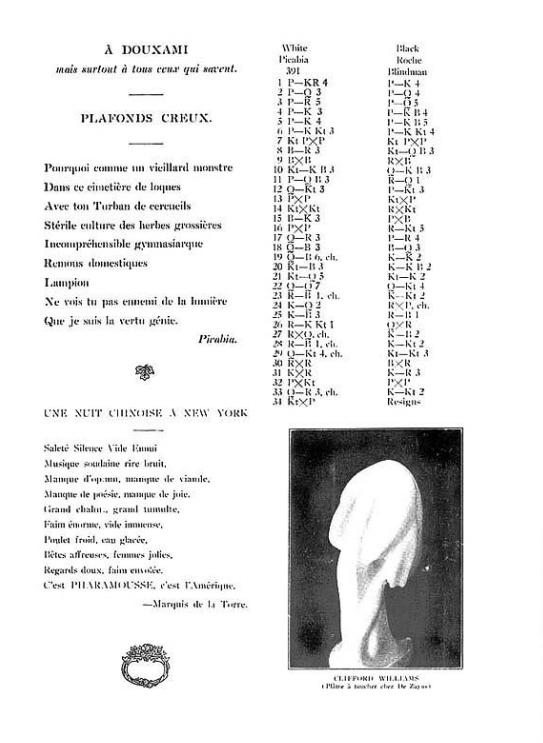
The game itself (1 h4 e5 2 d3 d5 3 h5 d4 4 e3 f5 5 e4 f4 6 g3 g5 7 gxf4 gxf4 8 Bh3 Nc6 9 Bxc8 Rxc8 10 Nf3 Qf6 11 c3 Rd8 12 Qb3 b6 13 cxd4 Nxd4 14 Nxd4 Rxd4 15 Be3 fxe3 16 fxe3 Rb4 17 Qa3 a5 18 Qc3 Bd6 19 Qc6+ Ke7 20 Nc3 Kf7 21 Nd5 Ne7 22 Qd7 Qg5 23 Rf1+ Kg7 24 Kd2 Rxb2+ 25 Kc3 Rf8 26 Rg1 Qxg1 27 Rxg1+ Kf7 28 Rf1+ Kg7 29 Qg4+ Ng6 30 Rxf8 Bxf8 31 Kxb2 Kh6 32 hxg6 hxg6 33 Qh3+ Kg7 34 Nxc7 Resigns) is bad and may be of little interest, but it possesses a certain dadaesque charm. The event is described on page 198 of Duchamp A Biography by Calvin Tomkins (New York, 1996):’
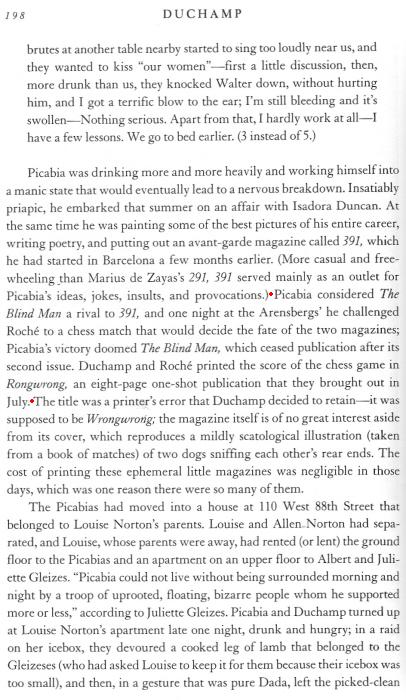
7193. Bogoljubow v Tartakower
A fast game of chess (but what were the exact conditions?) was given on page 168 of the August 1923 Wiener Schachzeitung:
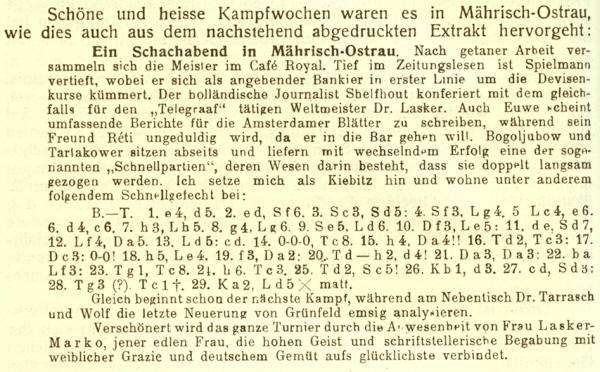
Efim Bogoljubow – Savielly Tartakower
Mährisch-Ostrau, 1923
Center Counter-Game
1 e4 d5 2 exd5 Nf6 3 Nc3 Nxd5 4 Nf3 Bg4 5 Bc4 e6 6 d4 c6 7 h3 Bh5 8 g4 Bg6 9 Ne5 Bd6 10 Qf3 Bxe5 11 dxe5 Nd7 12 Bf4 Qa5 13 Bxd5 cxd5 14 O-O-O Rc8 15 h4
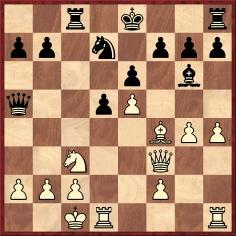
15...Qa4 16 Rd2 Rxc3 17 Qxc3 O-O 18 h5 Be4 19 f3 Qxa2 20 Rdh2 d4 21 Qa3 Qxa3 22 bxa3 Bxf3 23 Rg1 Rc8 24 h6 Rc3 25 Rd2 Nc5 26 Kb1 d3 27 cxd3 Nxd3 28 Rg3 Rc1+ 29 Ka2 Bd5 mate.
7194. Family check
A footnote on page 45 of Znosko-Borovsky’s The Art of Chess Combination (London, 1936):
‘Bogoljubow wrote of a “family check” administered by knight to king, queen and two rooks!’
The entry on ‘family check’ on page 100 of An illustrated Dictionary of Chess by Edward R. Brace (London, 1977) even stated that ‘the term was devised by Bogoljubow’.
The earliest citation that we have found is on page 54 of Alekhine’s Hastings, 1922 tournament book (or page 50 of the Dover edition):
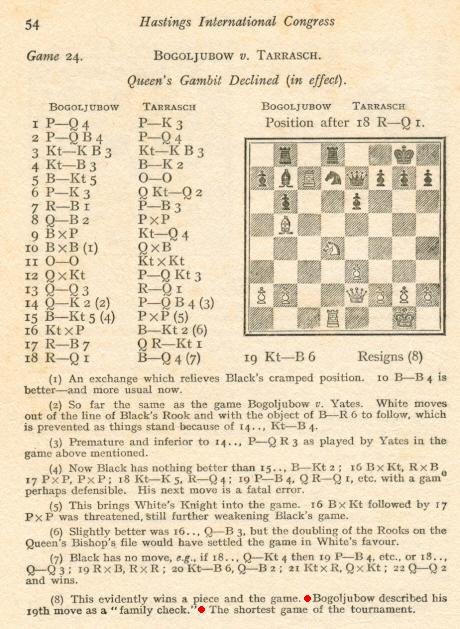
But why ‘family check’ in this instance, as opposed to ‘family fork’?
7195. Postcard
Richard Benjamin (St. Louis, MO, USA) asks whether information is available about a photograph (featuring Rudolf Spielmann) on a postcard in his possession:
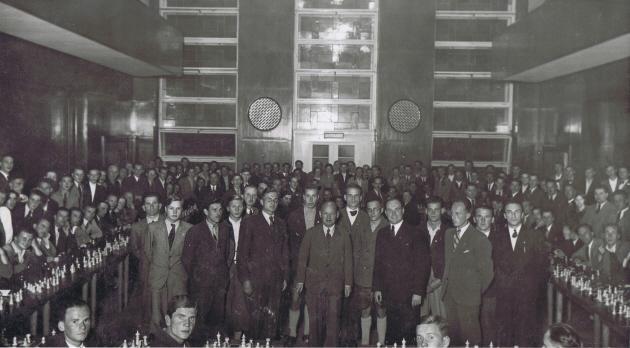
7196. Berlin, 1919
This photograph, taken during a small tournament in Berlin in February 1919, comes from page 15 of Bogoljubow’s book Izbrannye Partii (Leningrad and Moscow, 1926):
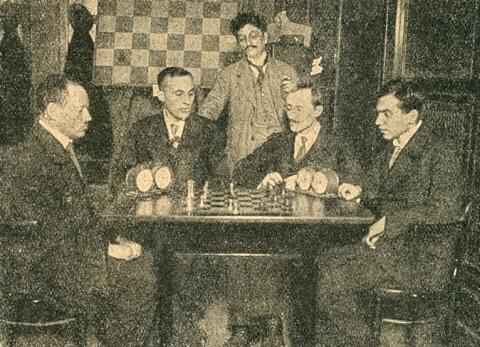
Seated from left to right: R. Spielmann, E. Bogoljubow, A. Selesniev and R. Réti. Standing: B. Kagan.
Is a copy of better quality available?
7197. Colditz
In C.N. 1460 Peter Wason (Goring-on-Thames, England) gave this quote from page 69 of Padre in Colditz: The Diary of J. Ellison Platt (London, 1978):
‘Monday, 6 January 1941
Chess, chess and more chess! The two sets we possess have been in constant – almost uproarious – demand since morning Appell. Conversation about anything but chess is impossible.’
7198. Metamagical Themas
Dr Wason also provided, in C.N. 1498, an extract from pages 208-209 of Metamagical Themas by Douglas R. Hofstadter (London, 1985):
‘A brilliant chess move, once the game is over and can be viewed in retrospect, can be seen as logical – as “the correct thing to do in that situation”. But brilliant moves do not originate from the kind of logical analysis that occurs after the game; there is no time during the game to check out all the logical consequences of a move. Good chess moves spring from the organization of a good chess mind: a set of perceptions arranged in such a way that certain kinds of ideas leap to mind when certain subtle patterns or cues are present. This way that perceptions have of triggering old and buried memories underlies skill in any type of human activity, not only chess. It’s just that in chess the skill is particularly deceptive, because after the fact, it can all be justified by logical analysis, a fact that seems to hint that the original idea came from logic.
Writing lovely melodies is another one of those deceptive arts. To the mathematically inclined, notes seem like numbers and melodies like number patterns. Therefore all the beauty of a melody seems as if it ought to be describable in some simple mathematical way. But so far, no formula has produced even a single good melody. Of course, you can look back at any melody and write a formula that will produce it and variations on it. But that is retrospective, not prospective. Lovely chess moves and lovely melodies (and lovely theorems in mathematics, etc.) have this in common: every one has idiosyncratic nuances that seem logical a posteriori but that are not easy to anticipate a priori. To the mathematical mind, chessplaying skill and melody-writing skill and theorem-discovering skill seem obviously formalizable, but the truth turns out to be tantalizingly more complex than that. Too many subtle balances are involved.’
7199. Steinitz’s children (C.N. 7189)
Russell Miller (Vancouver, WA, USA) notes that William Steinitz (‘Hardware Own Business’) and Juliet Steinitz (‘Stenographer for Bank’) were also listed in the 1920 US Federal Census. They were living with Peter and Elizabeth Baust at Queens Assembly District 6, Queens, New York.
7200. An old position (C.N. 7187)
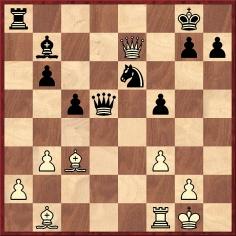
This situation (White to move) arose in a game between Alfredo Olivera and Carlos Hounie Fleurquin in Montevideo in September 1939. White played 1 Re1, but Alekhine, a participant in the tournament, showed the line 1 Be4 fxe4 2 fxe4 Qxe4 3 Qf7+ Kh8 4 Bxg7+ Nxg7 5 Qf8+ Rxf8 6 Rxf8 mate.
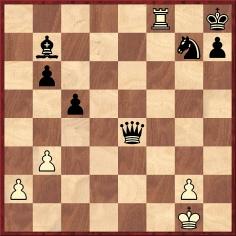
Our source is Brian Harley’s column in The Observer, 5 November 1939, page 16:
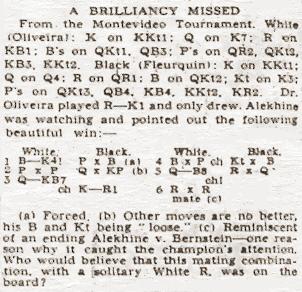
For Oliveira read Olivera, and it may be noted that 2...Qg5 would offer more resistance. Can the complete game-score be found?
7201. Janowsky in 1916
To Janowsky Jottings we have added two reports from US newspapers in January 1916 concerning Janowsky’s internment after the Mannheim, 1914 tournament, and his subsequent movements before arriving in New York at the beginning of 1916.
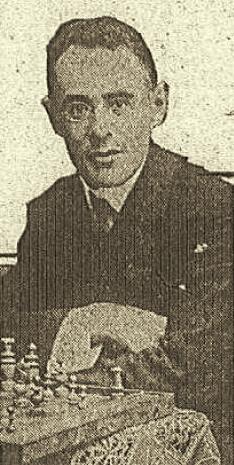
David Janowsky (Brooklyn Daily Eagle, 12 January 1916, page 2)
7202. Thorold v Green
A game played at the Philidorian Chess Rooms, London, from pages 204-205 of the Chess Player’s Magazine, July 1865:
Edmund Thorold – (Valentine?) GreenLondon, 1865 (?)
Scotch Gambit
1 e4 e5 2 Nf3 Nc6 3 d4 exd4 4 Bc4 Bc5 5 Ng5 Nh6 6 Qh5 Qe7 7 O-O d6 8 h3 Ne5 9 Bb3 Bd7 10 f4 Ng6 11 f5
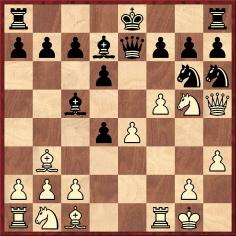
11...O-O-O 12 fxg6 d3+ 13 Kh1 hxg6 14 Qd1 f6 15 cxd3 fxg5 16 Nc3 g4 17 Nd5 Qh4 18 Qe1 g3 19 Rf4 Ng4 20 Be3 Bxe3

21 Qa5 Bb6 22 Nxb6+ cxb6 23 Qxa7 Nf2+ 24 Rxf2 gxf2 25 Rc1+ Bc6 26 Be6+ Kc7 27 Rxc6+ Kxc6 28 Bd5+ Kc5 29 Qa3+ Kd4 30 Qc3+ Ke3 31 d4+ Ke2 32 Bc4+ Kd1
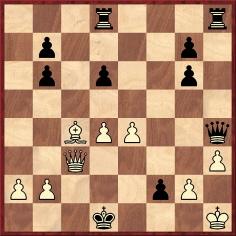
33 Qd3+ Kc1 34 Qe3+ Kxb2 35 Qd2+ Ka3 36 Qc3+ Ka4 37 Qb3+ Ka5 38 queen mates.
7203. ‘Someone once said ...’
Aben Rudy (Scottsdale, AZ, USA) asks for information about an observation quoted in a recent interview with Dominic Lawson:
‘Someone once said, “Chess is a battle between your aversion to the pain of losing, and your aversion to the pain of thinking”.’
7204. Emanuel Lasker and card games
Our Chess and Bridge article mentions the detailed examination of Emanuel Lasker’s involvement in bridge in the chapter ‘Nicht nur Schach Emanuel Lasker als Bridgespieler’ on pages 332-363 of Emanuel Lasker: Denker Weltenbürger Schachweltmeister edited by Richard Forster, Stefan Hansen and Michael Negele (Berlin, 2009).
The author of that chapter, Robert van de Velde (Amsterdam), informs us that he has now begun further research into Lasker and bridge (and other card games) and that among his recent discoveries is a Latvian book by Lasker on card games:
Kāršu spēles; Rokas grāmata visiem, kas vēlās iemācīties kāršu spēles. Derīgi padomi, aizrādījumi un paskaidrojumi tiem, kuŗi jau spēlēt prot. Sastādītā pēc Dr Emanueļa Laskera [,] un citiem autoriem. Rīgā [≤ 29-10-1936]; ‘Praktiskās Bibliotēkas’ izdevumā Rīgā, Avotu ielā 33.
According to a stamp on the copy inspected, publication must have been before 29 October 1936. In 1991 the book was reissued twice with revisions, by different publishers, the number of copies being specified as 20,000 and 30,000.
7205. Alekhine and alcohol
Golombek on Alekhine:
‘... even when drunk he could see a great deal further over the board than most chessplayers sober. I remember that, at the Warsaw International Team Tournament of 1935, I was showing a game I had won that day to the fellow members of my team. Alekhine came up, recognized the game and complimented me on it in mellow, if somewhat thickly intoxicated, tones and, in a flash, indicated a vital, winning variation we all had missed.’
Source: ‘Recollections of Alekhine’ by Harry Golombek, Chess
Review, May 1951, pages 140-141. See too C.N. 1313.
Golombek’s article can also be found on pages 191-196 of The
Treasury of Chess Lore by Fred Reinfeld (New York,
1951).
The relevant game from the 1935 Olympiad was not identified, but one possibility is Golombek v Horowitz. The former’s annotations on pages 480-481 of the October 1935 BCM referred to 24 h4 as a possible improvement suggested by Alekhine; at moves 28 and 33, shorter wins were pointed out by Golombek (without, however, any mention Alekhine).
7206. Skulduggery (C.N.s 4386 & 7129)
Another version of the tale, this time with Blackburne supposedly claiming that he was the player in question:
‘A good story is told by J.H. Blackburne, which runs as follows:
“When playing a game once at a London Chess Club I saw that by moving my king and allowing my opponent to capture my knight I could announce mate. Fearful that my opponent would notice this, I deliberately made a false move with the knight, and my opponent pounced upon this and made me move my king. Needless to say, my man took the knight, and I blandly announced mate in four.”’
Source: Chess Amateur, November 1921, page 36.
7207. Averbakh’s memoirs (C.N. 4847)

Yuri Averbakh
A question prompted by Centre-Stage and Behind the Scenes by Yuri Averbakh (Alkmaar, 2011): can any reader provide a potted biography of the Soviet chess official Dmitri Postnikov? He is seated between Vladimir Rydin and Semyon Tsarapkin in the photograph below from page 39 of Life, 12 July 1954, the occasion being the USA v USSR match (C.N. 7144):
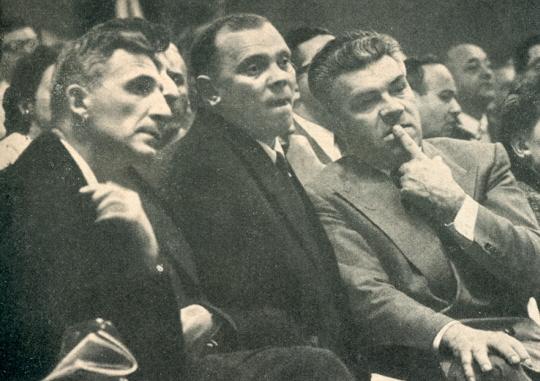
7208. The exchange
When did the term ‘winning the exchange’ first appear in chess literature, and why the word ‘exchange’? Similar questions may be asked about the phraseology in other languages (e.g. Qualität in German and qualité in French).
7209. Domination
‘I dominate them all!’ is a remark commonly ascribed to Alekhine. The earliest appearance known to us is on page 171 of the May 1946 CHESS:

This was part of a three-page feature ‘Alekhine ... The Man and the Master’ by Thomas Olsen (about whom we lack biographical information).
[Addition on 1 December 2014: regarding the above attribution to Olsen, see C.N. 8950.]
7210. Spielmann v Nimzowitsch
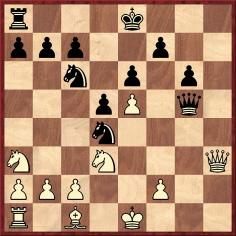
Black to move. Should he castle?
Richard Hervert (Aberdeen, MD, USA) draws attention to this position, which would have arisen in the game Spielmann v Nimzowitsch, Stockholm, 1920 if White had played Nimzowitsch’s suggestion of 17 Nf4-d3 (instead of the move actually played, 17 Be3).
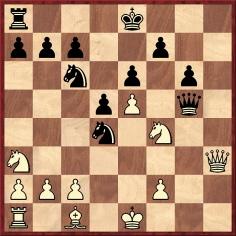
Position after 16...Qg5
On page 364 of The Praxis of My System (London, 1936) Nimzowitsch gave various lines beginning 17 Nd3 Qg1+.
However, Mr Hervert points out that on page 20 of A Complete Defence for Black by Raymond Keene and Byron Jacobs (London, 1996) there is no mention of 17...Qg1+ in reply to 17 Nd3. Instead, the book states in the note to 17 Be3:
‘White’s best is 17 Nd3!, when Black should play quietly with 17...O-O-O! when his prospects are still not bad. He is ahead in development with two pawns for a piece and with White somewhat tied up.’
Except, of course, that White can somewhat untie himself with 18 Bxg5, winning the queen for nothing.
7211. The exchange (C.N. 7208)
Robert John McCrary (Columbia, SC, USA) quotes from page 7 of A New Treatise on Chess by George Walker (London, 1833):
‘Exchange. You are said to win the Exchange, when you gain a rook for a bishop or knight.’
7212. Can Black win? (C.N. 7188)

The position was taken from page 145 of the 23 May 1915 issue of Deutsches Wochenschach:
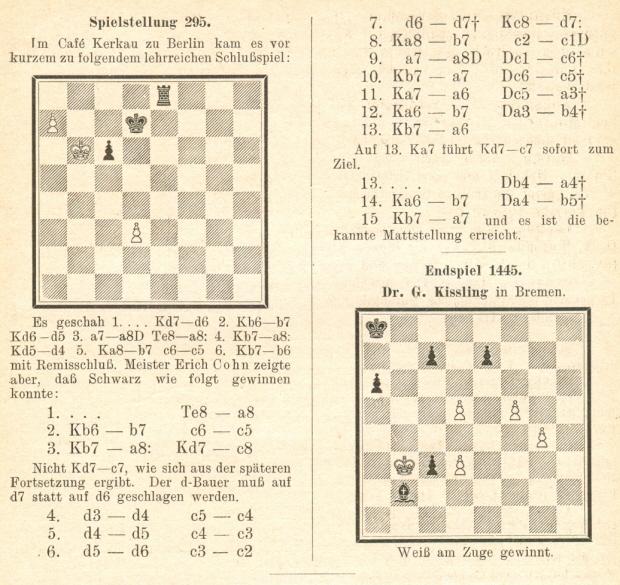
Erich Cohn pointed out how Black could have won with 1...Ra8. (1...c5 is also possible.)
The most detailed solution came to us from Owen Clarkin (Ottawa, Canada).
7213. Erich Cohn
C.N. 2634 (see page 197 of A Chess Omnibus) quoted from a book catalogue by Dale Brandreth concerning Schachmeister Erich Cohn (Berlin, 1919):
‘Scarce (many copies were destroyed by the Nazis because Cohn was Jewish). This was a little 18-page booklet dedicated to his memory since he was killed in action for Germany on 28 August 1918 after three years’ service.’
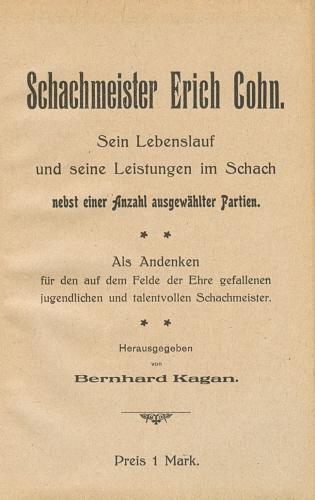
This photograph of Erich Cohn, not of premium quality, comes from page 354 of the ‘Jubiläums-Ausgabe’ of Kagans Neueste Schachnachrichten, 1926:
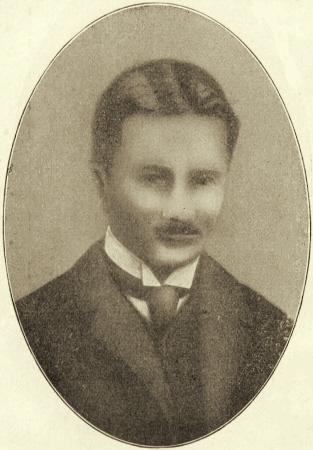
Erich Cohn is sometimes confused with Wilhelm Cohn, whose photograph appeared on page 143 of the Barmen, 1905 tournament book:
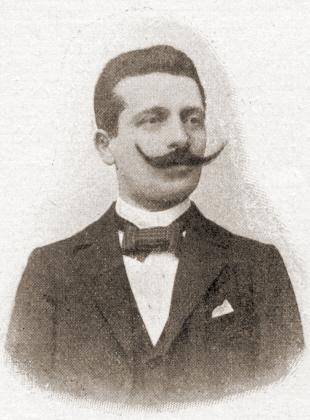
7214. Williams v Wight
P.H. Williams was not only a problemist. The game below, from a Hastings v Tunbridge Wells match, was given in C.N. 117, our source being page 476 of the Times Literary Supplement of 4 September 1919:
Philip Hamilton Williams – William Dundas WightHastings, 16 August 1919
Scotch Game
1 e4 e5 2 Nf3 Nc6 3 d4 exd4 4 Nxd4 g6 5 f4 d6 6 Bc4 Bg7 7 Nf3 Be6 8 Qd3 Qd7 9 O-O Bxc4 10 Qxc4 O-O-O 11 Nc3 f6 12 Be3 a6 13 a4 Nh6 14 Nd5 Rde8 15 Bb6 Qe6 16 Bxc7 Qxe4 17 Nd2 Qd4+ 18 Qxd4 Nxd4 19 Nc4 Kd7 20 Bxd6 Nhf5 21 Rfd1 Ne2+ 22 Kh1 Nxd6 23 Ndb6+ Kc7 24 Rxd6 Bf8 25 Rd7+ Kc6 26 c3 Bc5
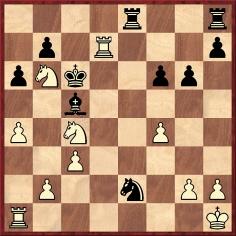
27 Na5+ Kxb6 28 Rxb7+ Kxa5 29 b4+ and mates next move. ‘A brilliant ending’, the Times Literary Supplement commented.
On page 336 of the September 1919 Chess Amateur Williams wrote about the game in a report on his visit to the Hastings Congress:
‘I overheard part of an interview with J.R. Capablanca, who was asked his opinion of problems. As a player, of course, he takes little interest in them, though a remarkably rapid solver. He says that they do not tend to improve one’s power as a player. Now, nobody interviews me, but were I asked my opinion of games, I should say that they do not improve one’s power as a problem composer. Am I not entitled to this view? Capablanca is an awfully nice fellow, and he has a way, I believe, of looking on his game, when Black, thus:
1 P-K4 (a)
(a) This loses.This is a useful attitude as it generally does lose. Yet I am told that it is the best move on the board. He himself plays it, when White, and when he does so, his visualization is thus:
1 P-K4 (a)
(a) This wins.Chess is a wonderful game, isn’t it?
I took a board against Blackburne, losing quite comfortably. I also played in a 33-board match, succeeding in taking away the nasty taste; for I managed to bring off a nice mate – quite after the problemist’s heart. I am bold enough to submit it to the Games Editor, and hope that he will be merciful with the weak play on both sides leading up to a rather saucy finish. The little shower of sparks comes at the end. There are no idle white pieces – thus conforming to the laws of problem construction.
But a strong player will discount the neatness of the mate on account of the weak play which preceded it; a problem composer does not bother about this question, so long as the position as diagrammed is a possible one; that is his postulate. Negatively, a problem which can be reached by reasonably good play ab initio is probably an inferior one.’
The Williams v Wight game was published, without notes, on page 38 of the November 1919 Chess Amateur.
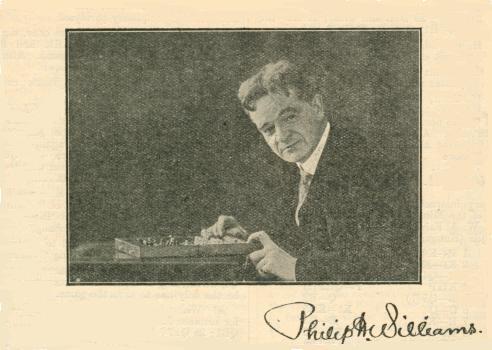
7215. Tandem chess (C.N. 4783)
C.N. 4783 included a photograph of Emanuel Lasker and Frank J. Marshall giving a simultaneous display of tandem chess (New York, 1906).
John Blackstone (Las Vegas, NV, USA) draws attention to a later report about the same players:
‘After leaving St Petersburg, Frank J. Marshall made his headquarters for the time being in Berlin, where, soon after his arrival, he played two exhibition games with Richard Teichmann at the Café Kerkau. The result was in favor of the German master, who scored 1½ points.
Shortly after, and at the same resort, Marshall had the honor of playing a tandem simultaneous exhibition with Dr Lasker as a partner. Twenty players were pitted against the pair, who came through with a score of 18 won and 2 drawn.’
Source: Brooklyn Daily Eagle, 2 July 1914, page 3.
Our correspondent asks whether any of the game-scores have survived.
7216. Beckner v Showalter
We note that the chess column on page 3 of the Brooklyn Daily Eagle, 2 July 1914 also published, with the winner’s notes, the following practice game, played ‘recently’:
John Taliaferro Beckner – Jackson Whipps Showalter
Occasion?
Sicilian Defence
1 e4 c5 2 Nf3 Nc6 3 d4 cxd4 4 Nxd4 g6 5 c4 Bg7 6 Be3 d6 7 Nc3 Nf6 8 Be2 O-O 9 O-O Ne5 10 h3 Be6 11 b3 Qc8 12 f4 Nc6 13 g4 Bd7 14 g5 Bxh3 15 gxf6 Bxf6 16 Rf2 e5 17 fxe5 Bxe5 18 Nd5 Qd8 19 Nf3 Bg3 20 Ng5 Bxf2+ 21 Kxf2 Be6 22 Qh1 h5 23 Bxh5 Kg7 24 Bg4 Rh8

25 Bxe6 Rxh1 26 Rxh1 Ne5 27 Bxf7 Qh8 28 Rxh8 Rxh8 29 Kg2 b5 30 cxb5 Rb8 31 a4 Nxf7 32 Nxf7 Kxf7 33 Bxa7 Rb7 34 b6 Ke6 35 Nc7+ Kd7 36 a5 Resigns.
7217. J’adoube
C.N. 54 reported that the magazine Land and Water, 28 June 1873 quoted the following advice from the Liverpool Weekly Albion:
‘If you see you have made a bad move retract it as soon as possible, of course saying, “J’adoube”, otherwise it might appear illegal to do so, and you must, of course, insist on the strict game – at least when it applies to your adversary. It is not well to allow more than another move to take place before availing yourself of this resource of genius, and therefore it is always well to keep your fingers hovering over the board in a loose kind of way as much as you can until you are satisfied you cannot improve on your play. By no means say “J’adoube” quickly, as if it were an afterthought, but calmly and deliberately, so that discussion may be checked in the outset. Another advantage in saying “J’adoube” may be found in the privilege of pushing about your own and your opponent’s men when he is in profound calculation. It is a cheerful diversion for you, and the expression makes it quite legal for you to do it. If you do not wish your opponent to suspect your line of play, consider first and decide quietly what it is to be, then solemnly place your finger on a perfectly remote square of the board. Frown and gaze intently for some time and mutter to yourself; then suddenly make your actual move. It comes on your adversary like a mental shower-bath or an electric shock, and takes his breath away.’
7218. Madame Reutlinger-Rosenthal
Graham Clayton (South Windsor, NSW, Australia) quotes an item from the chess column in the Queenslander, 7 July 1894, page 16:
‘La Stratégie mentions that Madame Reutlinger-Rosenthal is of the opinion that there is no player living who could give her the odds of a knight, and expresses regret that the distance between France and America precludes her from measuring her chess strength against Mrs Showalter’s.’
Our correspondent requests information about Madame
Reutlinger-Rosenthal and asks whether any of her games
have survived. Assistance from readers on these matters
will be appreciated.
Below is the report referred to by the Queenslander:
‘Le paragraphe que nous avons consacré à Madame Showalter, dans le numéro de février, nous a valu une protestation de Madame Reutlinger-Rosenthal qui estime que personne ne pourrait lui rendre le cavalier. Il est regrettable qu’une si grande distance sépare ces deux dames; après le match Lasker-Steinitz, un match pour la “Dame-Champion des Echecs” serait bien intéressant.’
Source: La Stratégie, 15 April 1894, page 119.
The earlier paragraph in the French magazine (15 February 1894 issue, page 55) read:
‘Madame Showalter est bien la digne compagne du vaillant champion du Kentucky; elle vient de le prouver en gagnant un match à M. E. Lasker, qui lui rendait seulement le cavalier, avec le merveilleux résultat de 5 à 2. Probablement aucune autre Dame ne pourrait obtenir un pareil succès contre le célèbre maître allemand.’
7219. Quincy
A. Brackett (C.N.s 6073 & 6087)

J.R. Capablanca v Q.A. Brackett, New York, 20 December 1906 (American Chess Bulletin, February 1907, page 24)
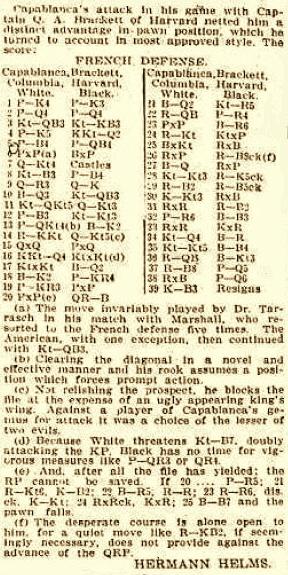
Brooklyn Daily Eagle, 6 January 1907, page 10
From page 34 of The Unknown Capablanca by David Hooper and Dale Brandreth (London, 1975):
‘Both Black’s 9th and 12th moves are imprecise; and they permit White to gain ground by 13 P-QN4, anticipating by some years the theory of blockade as expounded by Nimzowitsch.’
Olimpiu G. Urcan (Singapore) writes:
‘Regarding Quincy A. Brackett’s relationship/non-relationship with John Quincy Adams Brackett (1842-1918) – a matter discussed on page 177 of Chess Facts and Fables and in C.N.s 6073 and 6087 – the evidence that I have found indicates that the Harvard chessplayer was not the governor’s son.
In the US Census lists on which John Quincy Adams Brackett appeared there is no mention of a son with the name Quincy A. Brackett or anything similar. The 1880 census lists his only son, John G. Brackett. The 1910 census refers to the same son under the name J. Gaylord Brackett. There was also a daughter, Beatrice.
An obituary of J.Q.A. Brackett on page 126 of The Granite State Monthly: A New Hampshire Magazine devoted to History, Biography, Literature and State Progress (1918) stated that at the time of his death, when he had been residing in Arlington, he left behind a widow (Angie, or Angeline on census lists), a son (Judge John G. Brackett, of the Municipal Court) and a daughter (Beatrice Brackett).
I have also found a more detailed obituary of the chessplayer Quincy A. Brackett (1885-1951) in the Springfield Union (Springfield, MA) of 13 August 1951 (pages 1 and 5):
His wife, Ruth Wilson, died on 8 January 1963 according to the Springfield Union of the following day (pages 2 and 10). She was survived by a daughter, Mrs Alan C. Tindal, and three grandchildren.
The photograph of Q.A. Brackett given in C.N. 6087 (from page 170 of the March 1905 American Chess Bulletin) had appeared on page 5 of the Brooklyn Daily Eagle, 18 December 1904:’
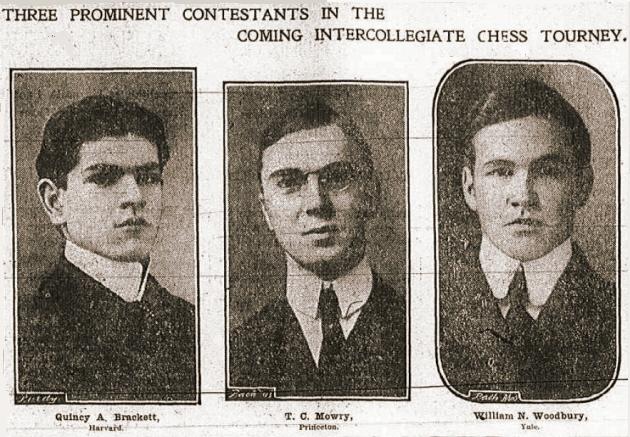
From page 4 of the January 1905 American Chess Bulletin we add a group photograph featuring Brackett (the occasion being the CHYP Tourney):
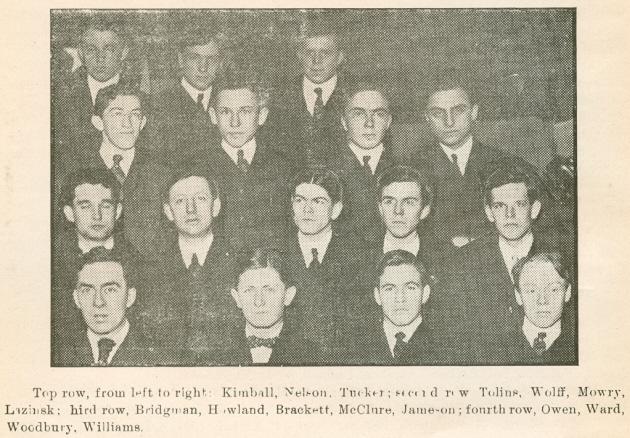
7220. Cable game
W.R. Greenhalgh (Pembroke, Cambridge) – Quincy A. Brackett (Harvard)Seventh Intercollegiate Cable Match, 23 March 1907
French Defence
1 e4 e6 2 d4 d5 3 exd5 exd5 4 Bd3 Bd6 5 Nf3 Nf6 6 O-O O-O 7 Bg5 Bg4 8 Nbd2 Nbd7
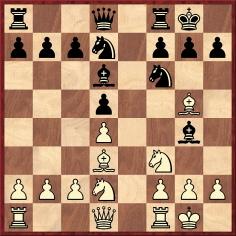
9 c3 Bh5 10 Re1 Re8 11 Qc2 Bg6 12 Rxe8+ Qxe8 13 Re1 Qf8 14 Bxf6 Nxf6 15 Ne5 Re8 16 Bxg6 hxg6 17 Qd1 Re7 18 g3 Qe8 19 f4 Nd7 20 Ndf3 f6 21 Nxd7 Rxe1+ 22 Qxe1 Qxd7 23 Qe2 Kf7 24 Kg2 Qe7 25 Qxe7+ Bxe7 26 Nh4 a5 27 Kf2 b5 28 Ke2 c5 29 dxc5 Bxc5 30 Kd3 f5 31 b3 Kf6 32 Nf3 Ba7 33 Ke2 Ke6 34 Nd4+ Bxd4 35 cxd4
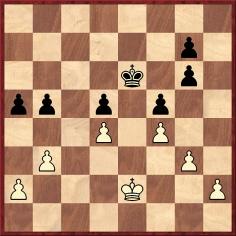
35...b4 36 Kf3 Kf6 37 Kg2 g5 38 fxg5+ Kxg5 39 Kf3 Kf6 40 Kf4 g5+ 41 Kf3 Kg6 42 h3 Kh5 43 h4 Kg6 44 Kg2 f4 45 Kf2 fxg3+ 46 Kxg3 gxh4+ 47 Kxh4 Kf5 48 White resigns.
Sources: Lasker’s Chess Magazine, April 1907, pages 260-261, and the American Chess Bulletin, May 1907, pages 95-96.
The game was played on board two in the six-board match. On board one Capablanca (Columbia) drew against H.J. Rose (Balliol, Oxford).
7221. For solving

White mates in three
7222. Texas prodigy
Russell Miller (Vancouver, WA, USA) points out a game on page 6 of the New York Evening Post, 12 January 1907 (published there with notes from the St Louis Globe Democrat):
Abie Solomon – W.B. MundelleSan Antonio, 24 November 1906
Bishop’s Opening
1 e4 e5 2 Bc4 d6 3 d3 Be6 4 Bb3 Nf6 5 h3 Nc6 6 Nf3 Be7 7 Nc3 h6 8 Be3 Qd7 9 O-O a6 10 Qd2 g5 11 Bxe6 Qxe6 12 Ne2 g4 13 hxg4 Qxg4 14 Ng3 Nh5 15 Nh2 Qg6 16 Nxh5 Qxh5 17 g3 Bg5 18 Qd1 Qg6 19 Qg4 Nd4 20 Bxd4 exd4 21 Nf3 Bf6 22 Qxg6 fxg6 23 Rfe1 O-O-O 24 e5 dxe5 25 Nxe5 Rdg8 26 Re4 h5 27 Nf3 c5

28 c3 dxc3 29 bxc3 h4 30 Nxh4 Kb8 31 Rc1 g5 32 Nf3 g4 33 Nh2 Rd8 34 Nxg4 Bg5 35 f4 Bxf4 36 gxf4 Resigns.
The Evening Post noted that the winner was aged 14. (‘A specimen of the Texan prodigy’s skill. In a match with the champion of Texas, the youth, though defeated, made an excellent showing.’) For biographical details about Abie Solomon, see Chess Prodigies.
7223. The Lutonians
The article below by G.H. Diggle first appeared in Newsflash, February 1983 and was included on page 91 of Chess Characters (Geneva, 1984):
‘The BM was delighted to read recently that T.W. Sweby, though retiring after 25 years as President of the Bedfordshire Chess Association, still remains President of the Luton Chess Club and each week casts an Elder Statesman’s eye upon the Chess World in his well-known Luton News column. For one who once played for “Beds” it is sad to read the County Match scores in Newsflash over the years and notice old names disappearing from the ranks. Too often has the BM had occasion to murmur (like Justice Shallow), “What? and is old Double dead?” Beds and its chess as he once knew it seem no more; “T.W.S.” alone remains, a well-known promontory towering above a now unrecognizable landscape.
Though in the bygone ’30s Beds never quite produced a Jim Plaskett, we had the redoubtable V. Ivanoff, a Russian-born engineer who came to Luton after winning the Lancashire Championship by defeating (among others) the renowned Gerald Abrahams. (His best-known game, however, is a “curiosity” at the Major Open, Yarmouth, 1935, where he lost his queen in 12 moves against L. Prins.) Other stalwarts were R.H. Rushton, who lived to be 87, and W. Church, who reached 93, while in the lower echelons were several great “characters”, including one venerable “reprobate” who was once “discharged with ignominy” from a Luton army playing in a “simul” against Eugene Znosko-Borovsky. The “sage” had an almost “grandmaster” reputation in the pubs he frequented, where it was considered a great feat even to know the moves, and he did not want it marred by a defeat being reported in the Luton News results and reaching the eyes of “publicans and sinners”. Perceiving that he was about to lose a piece but wouldn’t have been if only his RP had been on R4 instead of R3, he quietly “adjusted the matter” while the Master was still on his rounds. On reappearing, “Znosko” handled the situation gently by merely gazing at the “prodigal pawn” in mild disbelief and passing on without moving, clearly implying that should the criminal return it to base before “next time round” the incident would be closed. But next time round found the pawn still astray and the “bad shepherd” still brazen. Znosko quietly remarked “Not very nice”, lifted his king off the board, and went his way.
But the most brilliant Luton player (on his day) was the late J.E.D. Moysey (died 1951). He was Manager of the Midland Hotel and came to Luton about 1933, but was quite well-known in London chess before that, though he first played for Devon and in his younger days in a simul at Totnes against Dr Lasker completely bamboozled the world champion with a Falkbeer Counter-Gambit and won in just over 20 moves (the game is in the BCM, 1908, page 274). Moysey was a portly man of aristocratic mien and when presiding at his Hotel Bar frequently indulged in animated and dogmatic estimates of London players he had met – his favourite derogatory phrase, delivered in his strong public school accent, was: “He’s a mere CAFFYHOUSE player!” So often did he bring this out that it became a sort of shibboleth or “Hi, de, Hi!” in Luton chess circles; and R.H.R., T.W.S. and the BM (who resided in the same quarter of the town) on espying one another on opposite sides of the street would hurl insults across it – “Good morning Sir – I hope you realize you are a mere CAFFYHOUSE player!” “And you, Sir, are not even that – you poor BUN SHOP skittler!” It may be that we were the very first pioneers of the present horrible grading system – if so we have a lot to answer for.’
The Lasker v Moysey game, from the June 1908 BCM:
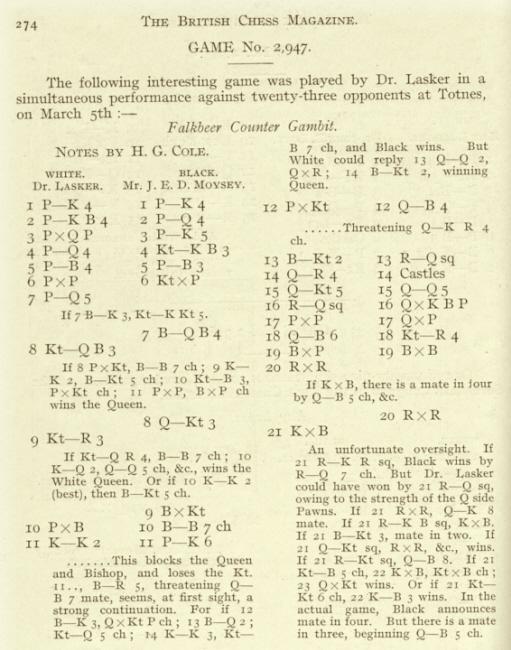
7224. Tartakower in Luton
A game from a simultaneous display in which Tartakower scored +17 –1 =0:
S.W. Dickens – Savielly TartakowerLuton, January 1928
Queen’s Gambit Declined
1 d4 d5 2 c4 e6 3 Nc3 Nf6 4 Bg5 Be7 5 e3 Nbd7 6 Nf3 O-O 7 Rc1 c6 8 a3 Ne4 9 Bxe7 Qxe7 10 Bd3 f5 11 O-O Rf6 12 Ne2 Rh6 13 Ng3
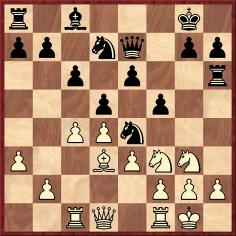
13...g5 (‘Fierce, but premature attack.’) 14 cxd5 (‘Initial move of a combination threatening to win two pawns and the exchange.’) 14...g4 15 dxe6 gxf3 16 Nxf5 Qxe6 17 Nxh6+ (‘17 Bc4, pinning the queen, would shorten the road to victory.’) 17...Qxh6 18 Bxe4 fxg2 19 Bxg2 Nf6 20 Qf3 Kh8 21 Rc5 Bg4 22 Qf4 Qxf4 23 exf4 Rd8 24 h3 Bh5 25 Rf5 Kg7 26 Re1 Rxd4 27 Re7+ Kg6 28 Rg5+ Kh6 29 Rxb7 Rxf4 30 Rc5 Bg6 31 Rxa7 Rd4 32 Rxc6 Nh5 33 Rac7 Rd1+ 34 Kh2 Rd2 35 Be4 (‘A good manoeuvre to gain freedom.’) 35...Rxf2+ 36 Kg1 Rxb2 37 Bxg6 hxg6 38 a4 Nf4 39 a5 Ra2 40 a6 Kh5 41 a7 Kh4 42 Rc4 g5 43 Rh7+ Kg3 44 Rc3+ Resigns.
Source: pages 19 and 68-69 of Chess in Bedfordshire by F. Dickens and G.L. White (Leeds, 1933).
7225. Leslie Burgin (C.N.s 4327, 4979 & 6714)
From opposite page 11 of the book mentioned in the previous item comes this plate:

7226. The exchange (C.N.s 7208 & 7211)
From Fabrizio Zavatarelli (Milan, Italy):
‘As far as I know, the earliest use of the Italian term “qualità” goes back to Lolli’s Osservazioni teorico-pratiche sopra il giuoco degli scacchi (Bologna, 1763). On page 24 Lolli gave 1 e4 e5 2 Nf3 Nc6 3 Bc4 Bc5 4 Kh1/Re1 (castling in accordance with the old Italian rules) 4...Bxf2 5 Rf1 Bc5 6 d4 Bxd4 7 Ng5 Nh6 8 Bxf7+ Kf8, with the reference “(a)”. On the next page he wrote:
“(a) Se il N. nel tratto 8. avesse in vece preso l’Alf. di Re col Cavallo, il B. lo avrebbe ripigliato col suo, offendendo con esso la Donna, ed il Rocco contrario; perlochè sarebbe venuto in guadagno almeno d’una Qualità.”
English translation: “Had Black instead taken the king’s bishop with his knight on the eighth move, White would have retaken it with his own, attacking the queen and the opponent’s rook with it; thereby he would have succeeded in winning at least an Exchange.”’
7227. Byrne v Bachmann
Javier Asturiano Molina (Murcia, Spain) asks whether Robert Byrne missed a mate in one against Peter Bachmann at the 1952 Olympiad in Helsinki, since there are databases which state that the game ended as follows:
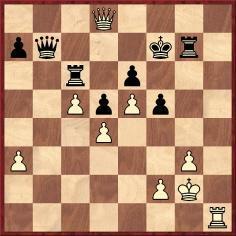
41 Rh8 Rg6 42 Rh7+ Rg7 43 Qh8 Resigns. However, 42 Qf8 mate would be possible.
We note that the conclusion was given on page 113 of Die Schacholympiade in Helsinki 1952 by Hans Müller (Vienna, 1953):
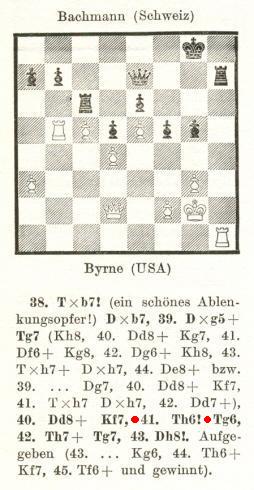
Thus White played not 41 Rh8 but 41 Rh6, and no mate in one was overlooked by Byrne.
7228. Quote attributed to Tartakower
According to one of the most famous chess quotes, regularly attributed to Tartakower, the winner is the player who makes the next-to-last mistake.
We would point out that the observation pre-dates Tartakower. For example, the following was on page 313 of the October 1890 Deutsche Schachzeitung:
‘Es ging in den Turnieren ziemlich bunt her. Der erste Rang im Meisterturnier wurde nach dem bekannten Witzworte entschieden, wonach derjenige gewinnt, welcher den vorletzten Fehler macht (s. Partie Nr. 5391).’
The game in question was Makovetz v Lasker, Graz, 1890, which was given on page 305 of the same issue:
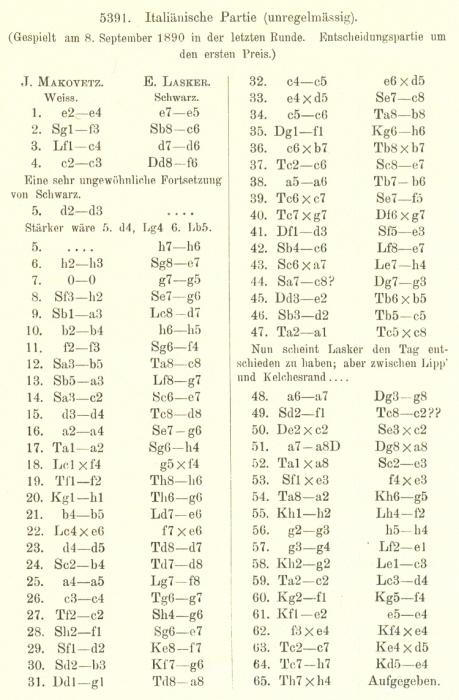
Another example of the remark is on page 167 of the June 1901 Deutsche Schachzeitung, in the notes by Alapin to Mieses v von Scheve, Monte Carlo, 1901:
‘Ein Fehler folgt dem anderen! Dieser hat aber den Vortheil, “der vorletzte” zu sein und muss deshalb gewinnen!’

7229. For solving (C.N. 7221)

Mate in three
This problem appeared with the reference ‘A. Ancin, Czechoslovakia’ on page 275 of the May 1971 Chess Life & Review, in the ‘Benko’s Bafflers’ column. The key move is 1 Nf1, and Pal Benko gave the full solution on page 315 of the June 1971 Chess Life & Review.
The composition was subsequently taken up in ‘Larry Evans on Chess’ on page 647 of the November 1971 issue. That item is reproduced here without comment:
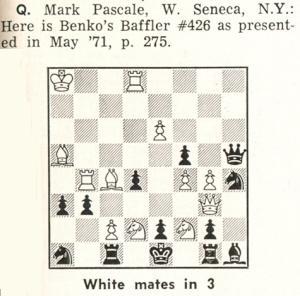

7230. Yates v Randall
Game-scores from F.D. Yates’ simultaneous displays are not particularly common. Below is one from a 19-board exhibition at the North London Chess Club, published on page 117 of the March 1928 BCM:
Frederick Dewhurst Yates – E.J. RandallLondon, 16 January 1928
Ruy López
1 e4 e5 2 Nf3 Nc6 3 Bb5 a6 4 Ba4 Nf6 5 O-O Be7 6 Re1 b5 7 Bb3 d6 8 c3 O-O 9 d4 exd4 10 cxd4 Bg4 11 Be3 Na5 12 Bc2 Nc4 13 Bc1 c5 14 b3 Nb6 15 Bb2 c4 16 Qe2 Re8 17 e5 dxe5 18 dxe5 Bxf3 19 Qxf3 Nfd7 20 Nd2 Bb4 21 Rad1 Bxd2 22 Rxd2 Nxe5

23 Bxh7+ Kh8 24 Qh5 Nf3+ 25 gxf3 Rxe1+ 26 Kg2 Qxd2 27 Bf5+ Kg8 28 Qh7+ Kf8 29 Qxg7+ Ke7 30 Qf6+ Kf8 31 Bc3 Qxc3 32 Qxc3 Rae8 33 Qf6 cxb3 34 axb3 Nd5 35 Qd6+ Ne7 36 Qh6+ ‘and mates in four’.
7231. William E. Griffin
From page 34 of the February 1905 American Chess Bulletin:
‘William E. Griffin is the name of one of the few members of the colored race known to be enthusiastic in the pursuit of chess. He hails from Kansas City, Mo., and is a participant in the pending Rice Gambit tournament of the Pillsbury National Correspondence Chess Association, and in this connection his portrait is used in the supplement to the February number. Readers of the Bulletin will no doubt relish a few particulars concerning the career of this interesting exponent of the game and accordingly the following biographical data supplied by him at the solicitation of the editors are presented. Born in the backwoods of Missouri, near the town of Fayette, on 17 May 1874. Griffin, at the age of 13, moved to Kansas City and went through the public schools there. He finished his education at the Kansas State University and is now engaged in the work of teaching school. A little more than three years ago, he learned the moves of the game and is now, to use his own words, “a burning chess enthusiast and an unwearying student of the game”. He boasts possession of a working library of some 25 volumes, which, however, he considers but a beginning. A few months after taking up the game he became a PNCCA member but failed to reach the semi-finals that year, his score comprising three wins and as many losses. In the eighth annual tournament he did succeed in attaining to semi-final rank and was awarded the usual bronze medal. In the Rice Gambit tournament he has so far not lost a game and feels sure of entering the final round. Besides his other accomplishments, Griffin claims to be able to play blindfold chess as easily as over the board and thinks that, with a little practice, he can conduct several games simultaneously. “I play chess”, writes Griffin, “because of the pure intellectual discipline and high aesthetic pleasure which the game affords. I do not know a great many of my race who are devotees of the Royal Game. In this city, however, it is the favorite pastime of a certain class, but I am not familiar with conditions in other cities. Wherever I go I introduce the game and find that it is is taken up readily.’
Griffin won sixth prize in the Rice Gambit tournament, as reported on page 375 of Twenty Years of the Rice Gambit (New York, 1916).
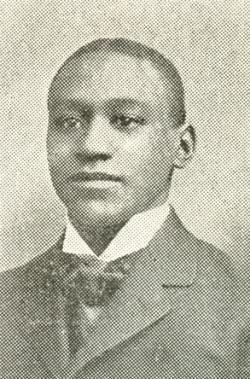
William E. Griffin on page 101 of The Rice Gambit by H. Keidanz (New York, 1905)
7232. Alekhine quotation (C.N.s 6704 & 6720)
From Steve Wrinn (Homer, NY, USA):
‘C.N.s 6704 and 6720 discussed the claim by Chernev that Alekhine “once” stated, “There must be no reasoning from past moves, only from the present position”.
There is a good example of this view, expressed in Alekhine’s own words, in his comments on a note by Euwe in game 19 of their 1937 world championship match, on pages 134-135 of Alekhine’s book The World’s Chess Championship 1937 (London, 1938).
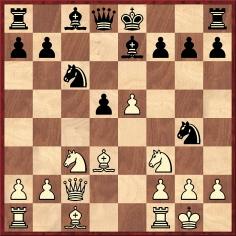
Euwe was White, and play went 13 Re1 Nb4 14 Bb5+ Kf8 15 Qe2 Bc5

16 Nd1. Having played 13 Rf1-e1, Euwe rejected 16 Re1-f1 and wrote:
“Of course not 16 R-B1, as this would admit something that was not true, namely, that 13 R-K1 was a mistake.”
Alekhine then added his own comment:
“An interesting remark, important for the comprehension of Dr Euwe’s chess personality; he simply does not want to admit that at the 16th move the best policy may be to return with the rook to KB1, and this solely because at the 13th move this rook went from KB1 to K1. For my part I confess that if I had White I would be satisfied with the fact that my 13th move had forced my opponent to lose the power to castle; and that I would have made my choice only on the basis of a close examination of the respective value of the moves possible – not taking into account which squares the corresponding pieces had occupied a few moves earlier. As a matter of fact it appears that 16 R-B1 would have been the simpler alternative; for in that case 16...B-B4 would have led to nothing after 17 P-QR3 Kt-B7 18 R-Kt1.”
So in this case a “once” quotation at least approaches the truth – for once.’
7233. Ten-year-old composer
On page 210 of the April 1922 Chess Amateur C.S. Kipping gave a problem by Ralph Zaak, aged ten, which had been published in the Newcastle Weekly Chronicle:
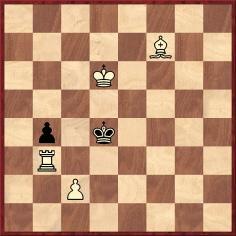
Mate in three
7234. Comic strip
An early example of a comic strip with a chess theme comes from the ‘Rhymo the Monk’ series by Gus Mager. It was reproduced on pages 320-321 of the October 1905 American Chess Bulletin, courtesy of the New York Evening Journal:
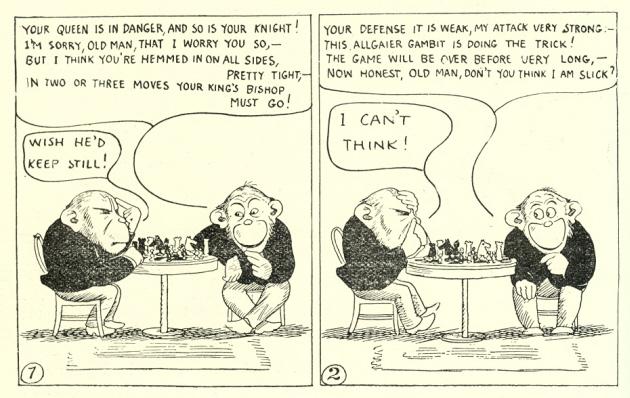
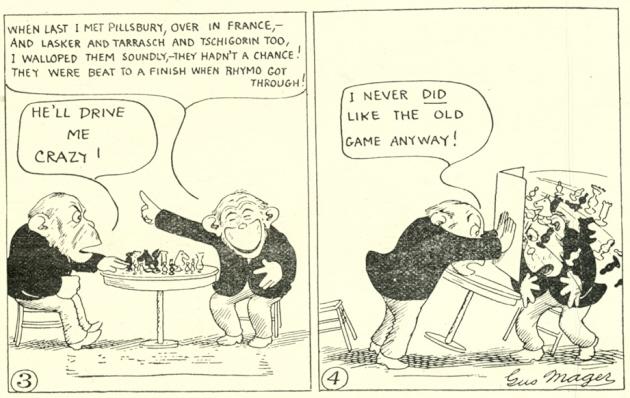
7235. Jacobsen v Spielmann
Below is an extract from an article by Tartakower (‘Schachmeister Dr Tartakower in Dänemark’) on pages 3-6 of the March 1923 Wiener Schachzeitung:

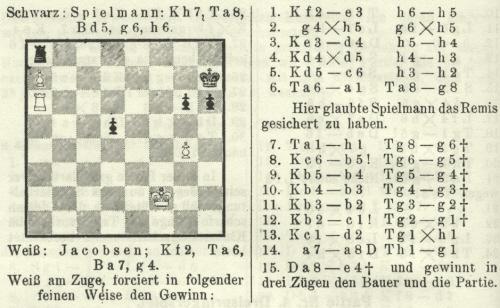
The play in this offhand game is of much interest:
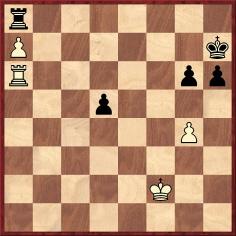
1 Ke3 h5 2 gxh5 gxh5 3 Kd4 h4 4 Kxd5 h3 5 Kc6 h2 6 Ra1 Rg8 7 Rh1 Rg6+ 8 Kb5 Rg5+ 9 Kb4 Rg4+ 10 Kb3 Rg3+ 11 Kb2 Rg2+
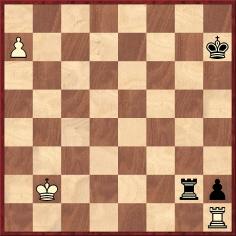
12 Kc1 Rg1+ 13 Kd2 Rxh1 14 a8(Q) Rg1 15 Qe4+ and wins.
Egil Jacobsen died on 27 March 1923, a fortnight after the Copenhagen tournament (Deutsche Schachzeitung, April 1923, page 77). Although he was only in his mid-20s, the group photograph in the tournament book suggests an older man hardly resembling the Egil Jacobsen shown on page 498 of Alt om Skak by B. Nielsen (Odense, 1943):

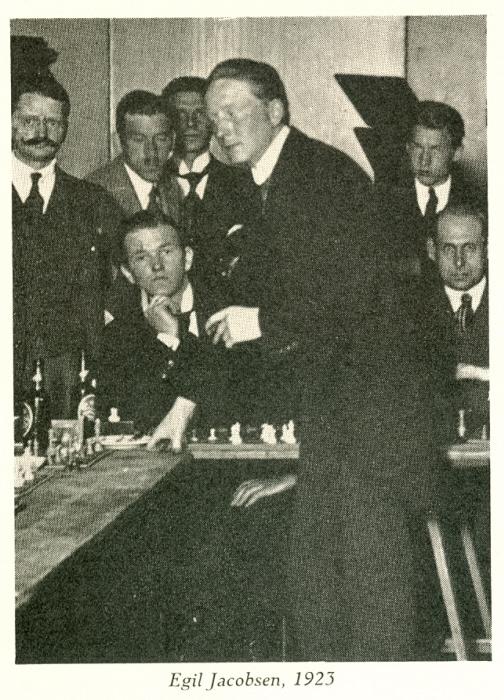
7236. Article by the prodigy Reshevsky
John Blackstone (Las Vegas, NV, USA) sends this article from page A11 of the Brooklyn Daily Eagle, 15 October 1922:
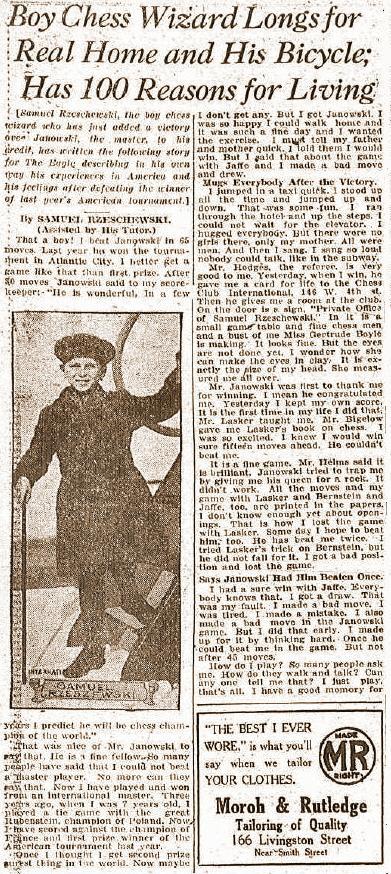
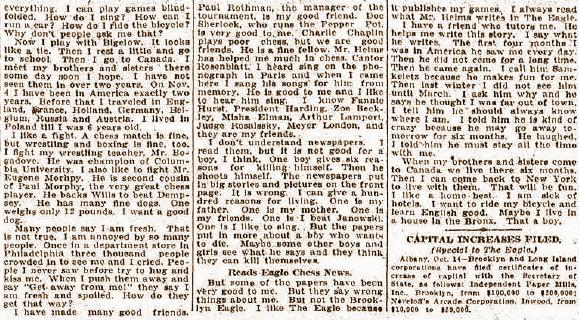
Among the points of interest are the boy’s comments on Janowsky, whom he had defeated in the New York tournament (see C.N. 6083). There is also an apparent reference to having drawn a game against Rubinstein in 1919. We note too the remarks about Charlie Chaplin.
7237. Almost everything
C.N. 7083 drew attention to Christian Hesse’s free and easy way of using other writers’ work in The Joys of Chess (Alkmaar, 2011). Now we are obliged to turn to Alles über Schach by Michael Ehn and Hugo Kastner (Hanover, 2010).
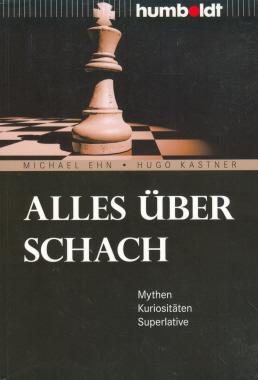
Three complete pages are shown below:
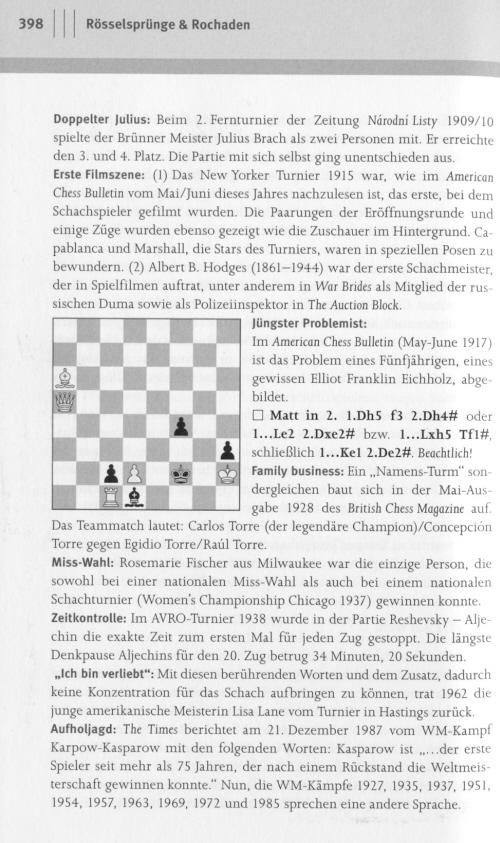
The ‘Doppelter Julius’ and ‘“Ich bin verliebt”’ items have nothing to do with our output. As regards the others:
‘Erste Filmszene’ is taken from pages 340-341 of A Chess Omnibus
‘Jüngster Problemist’ is taken from page 234 of Kings, Commoners and Knaves
‘Family Business’ is taken from page 125 of Chess Explorations
‘Miss-Wahl’ is taken from page 167 of A Chess Omnibus
‘Zeitkontrolle’ is taken from page 241 of Kings, Commoners and Knaves
‘Aufholjagd’ is taken from page 166 of Chess Explorations
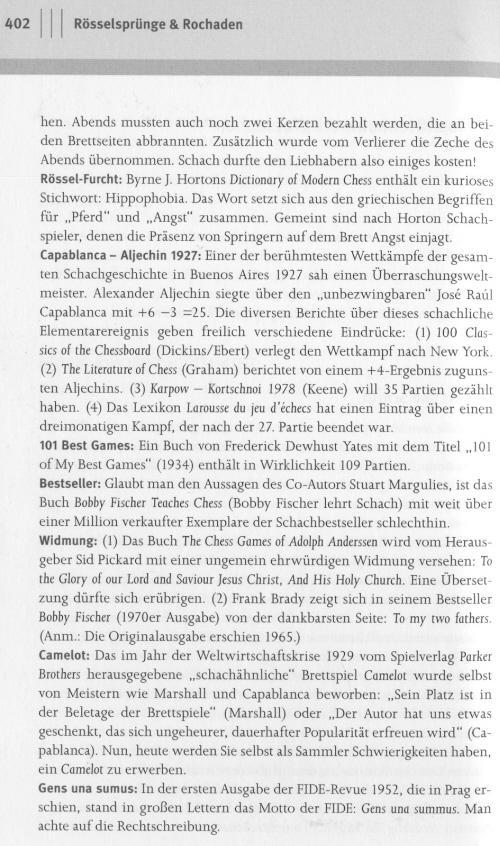
The ‘101 Best Games’ item has nothing to do with our output. As regards the others:
‘Rössel-Furcht’ is taken from page 144 of Chess Explorations
‘Capablanca-Aljechin 1927’ is taken from page 263 of Kings, Commoners and Knaves
‘Bestseller’ is taken from page 147 of A Chess Omnibus
‘Widmung’ is taken from page 237 of Kings, Commoners and Knaves
‘Camelot’ is taken from page 172 of A Chess Omnibus
‘Gens una sumus’ is taken from page 189 of Chess Explorations
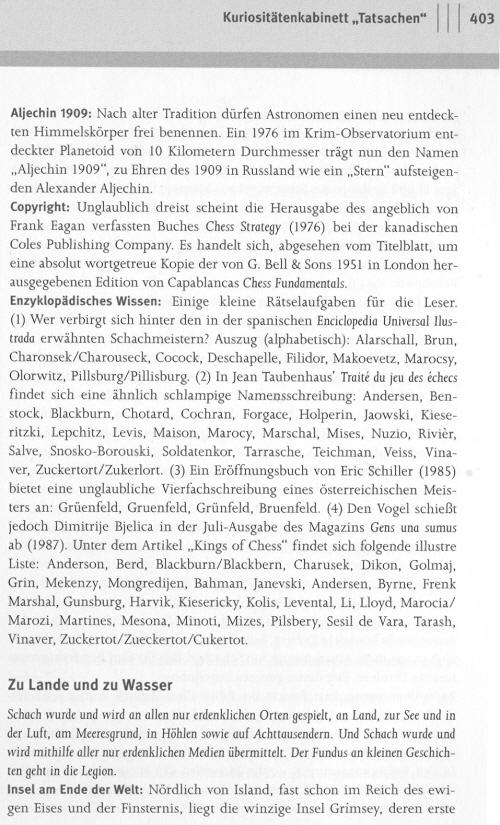
The ‘Aljechin 1909’ item has nothing to do with our output. As regards the others:
‘Copyright’ is taken from page 332 of A Chess Omnibus
‘Enzyklopädisches Wissen’ is taken from pages 143-144 of Chess Explorations (for the Enciclopedia), page 286 of A Chess Omnibus (for Taubenhaus), page 155 of Chess Explorations (for Schiller) and pages 167-168 of Chess Explorations (for Bjelica).
7238. Blackburne v Younger
An odds game played at the City of London Chess Club:
Joseph Henry Blackburne – YoungerLondon, 1871 (?)
(Remove White’s king’s knight.)
1 e4 e6 2 d4 d5 3 Nc3 c5 4 exd5 exd5 5 dxc5 d4 6 Ne4 Qe7 7 Bb5+ Bd7
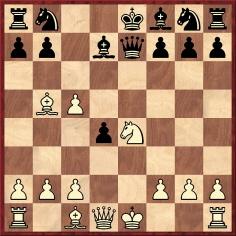
8 O-O Bxb5 9 Re1 Kd8 10 Bg5 f6 11 Nxf6 gxf6 12 Rxe7 Bxe7 13 Qxd4+ Nd7 14 b4 h6 15 Bf4 Bc6 16 Rd1 Kc8 17 c4 b6 18 cxb6 Bxb4 19 Qb2 Bc5 20 b7+ Bxb7 21 Rxd7 Bb6 22 Qb5 f5

23 Rc7+ Bxc7 24 Qe8+ Bd8 25 Qe6 mate.
Source: page 83 of the Westminster Papers, 1 September 1871.
7239. Hype regarding Morphy
‘Paul Charles Morphy is the greatest chess player known to history, and it is doubtful if there will ever be a better one. ... What it does seem is that he defeated the game of chess.’
These words were quoted in C.N. 17 from the first paragraph of the article ‘Wizard of Chess’ by Robert Cantwell on pages 1079-1081 of The People’s Almanac #2 by David Wallechinsky and Irving Wallace (New York, 1978). The piece originally appeared on pages 16-18 of Yesterday in Sports edited by John Durant (New York, 1956).
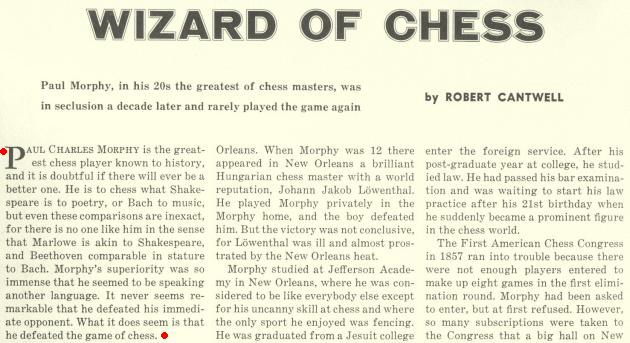
7240. William E. Griffin (C.N. 7231)
Russell Miller (Vancouver, WA, USA) has found a reference to William Griffin in the 1880 US Federal Census. Aged about five, he was living with his parents, Alexander and Jennie (both of whom had Missouri for their birthplace), in Richmond, Howard, Missouri. In the 1900 census William Griffin’s occupation was ‘High School Teacher’. His father’s birthplace was given as Virginia, and the family residence in 1900 was Kansas City Ward 10, Jackson, Missouri.
7241. Buenos Aires Olympiad, 1939
From page 199 of Chess Review, October 1939:
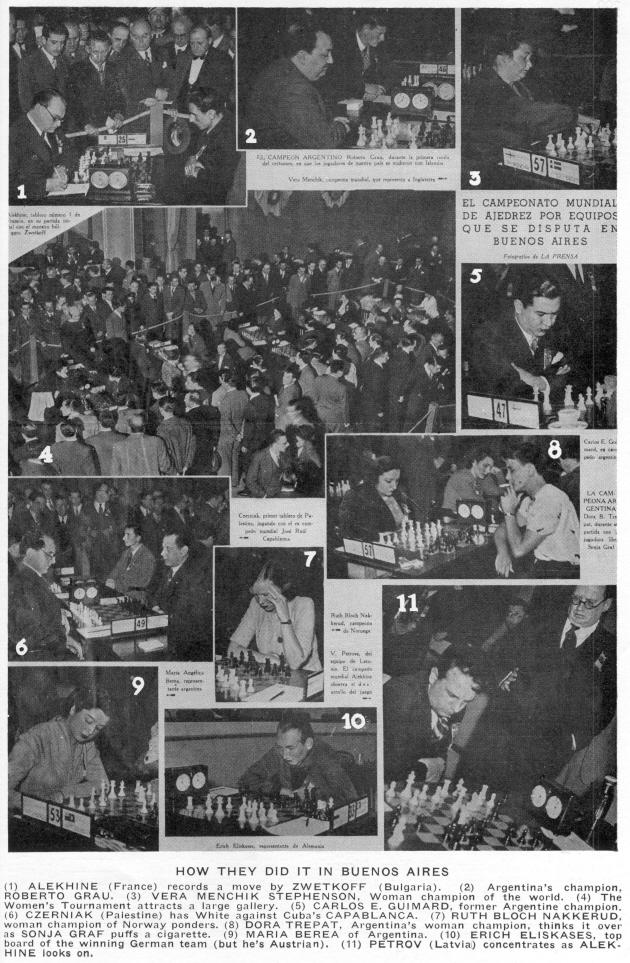
7242. Jacobsen v Spielmann (C.N. 7235)
Two issues arise from C.N. 7235: the circumstances of the 1919 Jacobsen v Spielmann game and the discrepancy over the caption to the Copenhagen, 1923 group photograph in which Jacobsen appeared.
Per Skjoldager (Fredericia, Denmark) notes that according to pages 118-119 of Skakbladet, April 1919 Spielmann had travelled through Denmark, staying in Copenhagen for two days (exact dates not specified by the Danish magazine). He gave two simultaneous displays, in the Studenterforeningen (Students’ Chess Club) and, the following day, in the Industriforeningen (Industrial Union Chess Club). His results were +19 –5 =6 and +19 –2 =6, respectively, but Egil Jacobsen was not among those named as winning or drawing. The full game-score of Jacobsen v Spielmann has not been found, and it is unclear where Tartakower obtained the ending for use in the Wiener Schachzeitung.
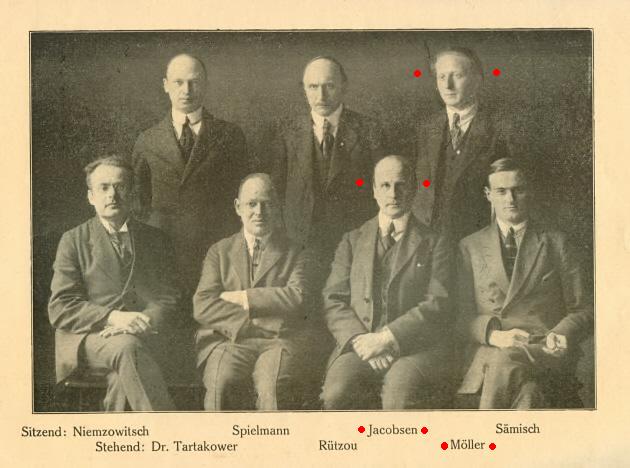
As regards the group photograph of Copenhagen, 1923, Mr Skjoldager notes – as do Thomas Henrich (Gießen, Germany) and Claes Løfgren (Randers, Denmark) – that in the tournament book’s caption there was an evident mix-up between Egil Jacobsen and Jørgen Møller.
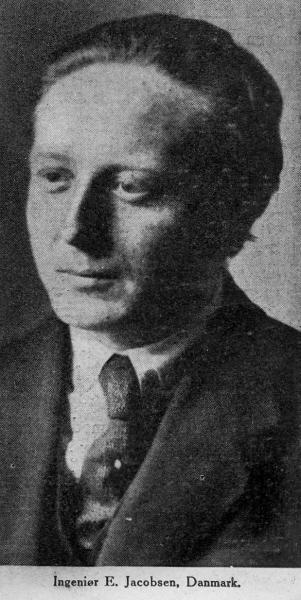
The above picture has been supplied by Mr Skjoldager. From the same source (the Danish magazine Verden og Vi, 1923, page 237) he also provides a photograph which will be in his forthcoming book on Nimzowitsch (C.N. 7108):
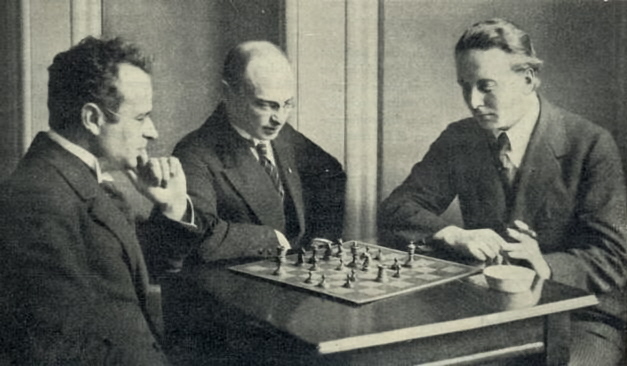
Aron Nimzowitsch, Savielly Tartakower and Egil Jacobsen
Mr Løfgren draws attention to Jacobsen’s obituary on pages 115-116 of the April 1923 issue of Skakbladet. It begins (in our correspondent’s translation from the Danish):
‘The champion of Denmark Egil Jacobsen died on 27 March, aged only 26, from a throat abscess which led to blood poisoning. He was participating in a tournament for the championship of Copenhagen and had played only a couple of games when the disease forced him to withdraw; however, nobody thought that the fresh young man would perish within a few days.’
Also received from Mr Løfgren is this picture of Jørgen Møller, from page 16 of the January 1933 Skakbladet:
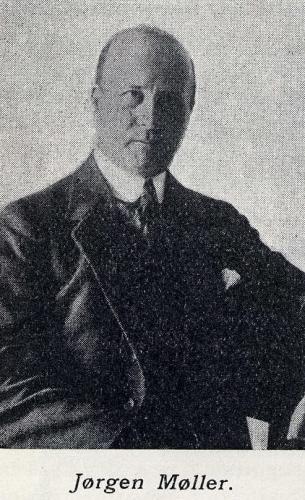
7243. Presley, Louis, DiMaggio and Capablanca
Tony Bronzin (Newark, DE, USA) quotes from page 471 of Careless Love: The Unmaking of Elvis Presley by Peter Guralnick (Boston, 1999) an account of a concert at Madison Square Garden on 9 June 1972:
‘The New York Times alone ran three stories on the show, with the headline of Chris Chase’s piece, “Like a Prince from Another Planet”, summing up the overall reaction. “Once in a great while”, Chase concluded, “a special champion comes along, a Joe Louis, a José Capablanca, a Joe DiMaggio, someone in whose hands the way a thing is done becomes more important than the thing itself. When DiMaggio hit a baseball, his grace made the act look easy and inevitable ... Friday night, at Madison Square Garden, Elvis was like that. He stood there at the end, his arms stretched out, the great gold cloak giving him wings, a champion, the only one in his class.”’
Mr Bronzin wonders whether the ellipsis between the words ‘inevitable’ and ‘Friday’ indicates the omission of a description of Capablanca by Chase, but we note from the original article (New York Times, 18 June 1972, page D14) that such is not the case:
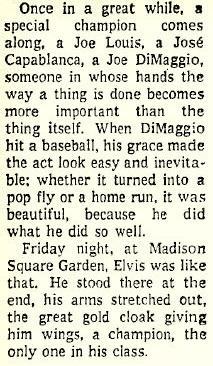
7244. Game
by Kennedy and Mackenzie (C.N.s 5926, 5931, 5951 &
6462)
The game 1 e4 e5 2 Bc4 Nf6 3 d4 c6 4 dxe5 Nxe4 5 Ne2 Nxf2 6 O-O Nxd1 7 Bxf7+ Ke7 8 Bg5 mate was given in C.N. 5926, and subsequent items showed a similar skirmish, one move shorter, in which White offered the odds of his king’s knight: 1 e4 e5 2 Bc4 Nf6 3 d4 Nxe4 4 dxe5 Nxf2
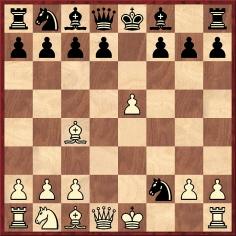
5 O-O Nxd1 6 Bxf7+ Ke7 7 Bg5 mate.
This seven-move victory was attributed to H.A. Kennedy on page 298 of volume five (1844) of the Chess Player’s Chronicle (C.N. 5951) and to G.H. Mackenzie on page 2 of the New York Times, 12 January 1871 (C.N. 6462).
On pages 188-189 of the Westminster Papers, 1 April 1873 it was ascribed to Mackenzie, submitted by ‘a correspondent at Nassau, NP, Bahamas’. Kennedy responded as follows on page 2 of the 1 May 1873 issue:

7245. Allies v Rubinstein
1 e4 e5 2 Nf3 Nc6 3 Bb5 a6 4 Ba4 Nf6 5 O-O d6 6 d4 b5 7 Bb3 Nxd4 8 Nxd4 exd4 9 c3 dxc3 10 Nxc3 Be7 11 a4 b4 12 Nd5 O-O 13 Nxb4 Bb7 14 Bd5 Nxd5 15 Nxd5 Rb8 16 b3 f5 17 f3 fxe4 18 fxe4 Rxf1+ 19 Kxf1 Bf6 20 Ra2
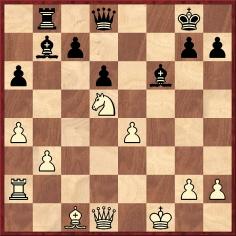
20...Be5 21 g3 c6 22 Ne3 c5 23 Qg4 Bc8 24 Qd1 Bh3+ 25 Ke1 Bc3+ 26 Bd2 Bd4 27 Qc2 Qf6 28 Bc1 Qf3 29 Qd3 Qh1+ 30 Nf1 Re8 31 White resigns.
‘Allies v Rubinstein, Berlin, 1922’ is the only information usually supplied for this game. See, for instance, page 145 of Akiba Rubinstein’s Chess Academy by V. Glatman (Moscow, 1992) and page 250 of Akiba Rubinstein: The Later Years by J. Donaldson and N. Minev (Seattle, 1995).
The allies were named when the game was given on pages 82-83 of Schachjahrbuch 1922 by L. Bachmann (Ansbach, 1924): Wegemund, Wagner, Friedrich and Berggrün. The heading was merely ‘Beratungspartie im Berliner Schachverein von 1876’ and the source indicated was the Vossische Zeitung. Can further particulars about the game be found there?
7246. Dziobek v von Scheve
Within a series of articles ‘Problem themes in play’ T.R. Dawson gave this position on page 170 of the August 1942 BCM:

‘Dziobek v von Scheve (1922)’
Dawson wrote:
‘Black has a very neat win by 1...K-Kt7 2 R-Kt8ch B-Kt5! 3 RxBch (this is a Roman decoy) K-R6 4 R-Kt8 P-B8(Q)ch 5 KxQ P-R8(Q)ch wins.’
The date 1922 may derive from the fact that the ending was published on page 328 of that year’s Schachjahrbuch by Bachmann, at the end of von Scheve’s obituary. He died in Patschkau (Paczków) on 19 April 1922. Jeremy Gaige’s Chess Personalia also records that Otto Dziobek died in Berlin on 15 March 1919.
What more can be discovered about the Dziobek v von Scheve game?
7247. Rees v Maróczy
A game ‘played in order to test a particular variation 3...P-QKt4’:
Leonard Percy Rees – Géza MaróczyLondon, 1922
Irregular Opening
1 d4 e6 2 c4 c5 3 d5 b5
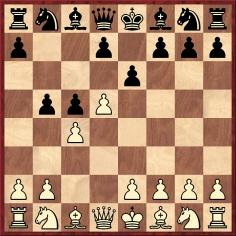
4 b3 Bb7 5 dxe6 fxe6 6 Bb2 d5 7 cxb5 Nf6 8 e3 Bd6 9 Bd3 O-O 10 Nf3 Nbd7 11 O-O e5 12 e4 d4 13 Nbd2 Qe7 14 Qe2 Nh5 15 g3 g5 16 Nc4 Bc7 17 a4 Rae8 18 Rae1 Ng7 19 Bc1 h6 20 a5 Bc8 21 Ba3 Qf6 22 Nfd2 Qg6 23 b4 cxb4 24 Bxb4 Rf7 25 Nb3 Ne6 26 Bd6 Bxd6 27 Nxd6
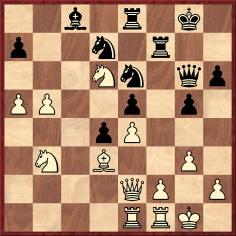
27...Nf4 28 Qa2 Nxd3 29 Nxe8 Nxe1 30 Rxe1 Nf8 31 Nc5 Bg4 32 Qd5 Ne6 33 Nd7 Nc7 34 Nef6+ Kg7
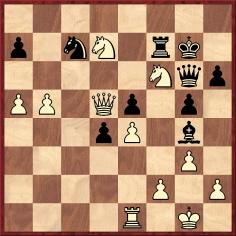
35 Qxe5 Rxf6 36 Nxf6 Qxf6 37 Qxc7+ Kg6 38 e5 Qe6 39 b6 axb6 40 axb6 d3 41 b7 d2 42 Rb1 Qb3 43 Qc6+ Kf5 44 Qd7+ Resigns.
Sources: CHESS, 14 October 1938, pages 55-56, and BCM, February 1945, pages 32-33.
CHESS reported:
‘Not so long ago, on a certain summer’s day in 1922, Mr Rees met, at the City of London Chess Club, the Hungarian master Maróczy, who asked him his opinion of the “Wing Gambit” or “Blumenfeld counter-gambit” in the Benoni opening. The question led to their sitting down and playing a serious game in which the master was decisively beaten ... It is hardly possible to suggest any improvement to Mr Rees’s play throughout.’
7248. N.N. v Rees
‘This brilliant little offhand game was lately won by the Hon. Secretary of the BCF’:
N.N. – Leonard Percy ReesOccasion?
Vienna Gambit
1 e4 e5 2 Nc3 Nf6 3 f4 d5 4 d3 dxe4 5 fxe5 Ng4 6 Nxe4 Nc6 7 c3 Ngxe5 8 d4 Qh4+ 9 Ng3 Bg4 10 Be2 O-O-O 11 Bf4 Bc5
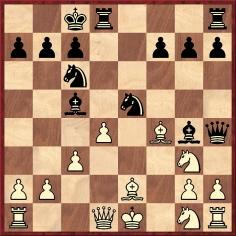
12 Qa4 Bxe2 13 Nxe2 Nd3+ 14 Kf1 Nxd4 15 cxd4 Rxd4 16 Nxd4 Qxf4+ 17 Ke2 Rd8 18 Ngf5 Qe4+ 19 Kd2 Bb4+ 20 Qxb4 Nxb4 21 Kc3 c5 22 Rhd1 cxd4+ 23 Nxd4 a5 24 a3

24...Rxd4 25 axb4 Qe3+ 26 Kc2 Qe2+ 27 Kb3 Qc4+ 28 Ka3 axb4+ 29 Ka4 b3+ 30 Ka3 Qa4 mate.
Source: Chess Amateur, November 1919, page 39.
| First column | << previous | Archives [85] | next >> | Current column |
Copyright: Edward Winter. All rights reserved.

